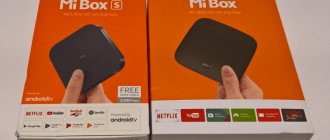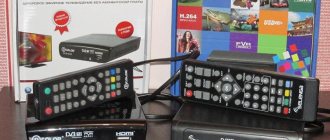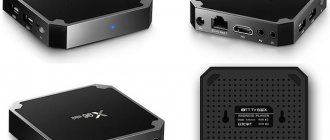Design
We start our Xiaomi Mi Box 3 review with its appearance and immediately note that the console looks very impressive. It pleasantly surprises with its compact size and smooth shapes. This once again shows that it was not for nothing that Xiaomi designers were awarded several awards for the design of TV set-top boxes.
At the bottom there is a rubberized round clamp, thanks to which the device practically does not slip on the surface.
The Xiaomi Mi TV Box 3 review informs you that on sale you can only find a black version made of semi-matte plastic. The solution is not the most practical - fingerprints are very visible. The Mi series logo was placed closer to the front side of the case.
Regarding the build quality, everything is perfect - the case is strong and reliable, has no gaps and does not creak if you press hard on it.
Mi Box 3 pro review showed that an infrared port and an LED indicator were placed on the front side.
Space for other functional elements has been allocated at the back - an HDMI port, a USB port, a connector for connecting a network adapter and a 3.5 mm audio input.
Minuses
The Xiaomi Mi Box TV set-top box has no significant drawbacks. Among the inconveniences, users note the lack of Russian language on the built-in keyboard.
This problem can be solved by installing any keyboard from other developers from Google Play. Another inconvenience noted by the owners of the product is that there is no pre-installed web browser. The Google Play service allows you to download applications, but only those that can be used from the remote control. There are few such programs; among them there are no browsers, social networks, or system applications. However, thanks to USB support, the user can install the programs he needs from a flash drive. The situation is similar with games. The store presents only those that are controlled from a remote control or gamepad.
Full setup of Mi Box
Setting up Mi Box is a fairly simple task if you pay attention.
All steps in detail:
Press the power button on the remote control to turn on the device. The Android splash screen appears, followed by the Welcome screen. At this stage, select Russian from the proposed list.
A question will appear on the screen if you want to do a quick setup using your Android phone or tablet. If there is no such device, you will have to enter the passwords for Wi-Fi and Google account manually.
Open the official Google app on your phone and type “Device Settings.”
- Sync two devices using a verification code. Compare them and if they match, confirm this in the application.
- The program will automatically copy accounts, settings and connect to the Internet.
This will open the main Android TV interface.
Xiaomi Mi Box S review
Peculiarities
Let's start with the fact that the Xiaomi Mi Box S media player in question received this name only outside of China. In its homeland, this model is called Xiaomi Mi Box 4. The main difference between Xiaomi Mi Box S and Xiaomi Mi Box 3 (its predecessor) is the updated design and improved remote control, which adds voice control.
Those who have already reviewed the new version say that the Xiaomi Mi Box S player's hardware and capabilities are almost the same as the Xiaomi Mi Box 3. In terms of hardware, the Xiaomi Mi Box S comes with an Amlogic S905X SoC chip. The Mi Box S has 2 GB of DDR3 RAM and 8 GB of flash memory for storage.
Xiaomi Mi Box S supports codecs such as H.265, VP9, H.264, VC-1, MPEG1/2/4, and Real8/9/10. The menu will include many foreign languages, which will allow the device to be in demand in many countries.
Remote controller
The Mi Box S player has a new remote control with support for Google Assistant. Since most users prefer to have Google Assistant, the remote control has a dedicated button. Thus, voice control is possible directly via the remote control. The remote also has a separate button for the Netflix Internet platform. The hardware has minor updates compared to the Box 3 version.
Advantages and disadvantages
The Mi Box S media player was demonstrated as a device that supports HDR. This is true, but if expressed in Odessa language, then “yes, but no.” The “diversity” of supported HDR standards comes down to only supporting static HDR10 data. Xiaomi's Mi Box S media box does not support Dolby Vision, and there is no need to talk about the free HDR10+ format at all.
As for audio modes, the problem is approximately the same. The device perfectly reads formats such as DTS and Dolby Digital, but it does not support object-based audio formats such as Dolby Atmos and DTS: X. We must assume that the manufacturer did not equip the Mi BoxS with these technologies in order to reduce the cost of the model.
Smart TV
Mi Box S, like its predecessors, is based on Google's Android TV platform. With Google Play Store certification, you have access to apps like Netflix, HBO, Hulu, and YouTube, which can be installed from the 8GB of built-in storage. There's also Chromecast support, but be aware that the Chromecast software implementation is locked to 60Hz video output.
The same Android TV platform is used in TVs from Sony, Philips, TCL and others. The Nvidia Shield player contains the same platform. According to some consumers, the performance of such a platform lags slightly behind Apple tvOS, Roku and Amazon FireTV. In addition to equipping the smart system with the Oreo voice assistant, Google has provided a new user interface.
She hopes that such an update will become more accessible to many users on an intellectual level. The same interface will be implemented on other devices based on Android TV. The Mi Box S is also compatible with wireless game controllers, but don't expect the hardware to deliver perfect graphics.
Connections
Xiaomi Mi Box S has available interfaces such as Wi-Fi 802.11 ac, HDMI 2.0a, Bluetooth 4.2, USB 2.0 and 3.5 mm audio output for headphones. There is also a network connection. Product dimensions are 95.25 x 95.25 x 16.7 mm. The device weighs 147 grams. In addition to the Mi Box S itself, the package includes a remote control and two batteries, as well as a manual, power adapter and HDMI cable.
Equipment: everything you need
The devices are delivered in traditional cardboard packaging, which prevents damage during transportation. Inside, in addition to the device itself, there are such elements as a network adapter (comes with a Chinese plug), instructions in Chinese and an HDMI cable.
The Xiaomi Mi Box 4 and Pro also includes a remote control, but it is missing in the 4C modification.
Use cases
First of all, such a set-top box will be of interest to owners of TVs that lack smart functions. But it can also serve as a new “brains” for an outdated Smart TV, which no longer receives updates or installs applications. Mi Box is no less convenient for broadcasting images from a smartphone to a monitor or TV. This way you can view your browser tabs, photos on the big screen. Very convenient for a large company. A slightly stranger, but nevertheless feasible scenario is transferring games from a smartphone to a larger diagonal. But this operating scenario has one serious drawback - a noticeable delay in the signal from the wireless joystick to the console, so you can’t play dynamic games like runners or shooters comfortably.
If you have an Android smartphone, then what?
For the last two weeks I have been using Google Pixel 4a smartphones as my main one. I think I’ll share my impressions after using the iPhone in the near future.
In this scenario, you will get more goodies - from broadcasting videos from a browser to universal applications for smartphones and TVs.
There are various workout apps that allow you to take heart rate information from a smartwatch connected to a smartphone and display it on the TV screen. Apple did something similar in its Fitness+ service.
You can also note duplicating the smartphone screen onto a TV, which is also a useful thing in some cases. For example, you can show photos and videos from the gallery. Or turn on the presentation. Although for something like this, I would better recommend purchasing a Google Chromecast . It will be more expensive, but more interesting.
Setting up IPTV
What is IPTV? — Without delving into the terms, this is Internet television that allows you to watch TV channels live.
There are two ways to configure the technology:
- Using regular Android programs, where the main 100-300 channels of Russia, Ukraine and the CIS are already preinstalled.
- Use the Kodi player, in which you can add and edit your playlists, watch movies, TV series, and in general - much more functionality.
In this article we will talk about the first method, since it will be sufficient for most users.
Installation will take literally 2-3 minutes.
So, let's look at 3 applications for IPTV (They are all available on Aptoide):
- Peers.TV;
- Lazy IPTV;
- IPTV Pro;
You can install them like everyone else. No additional configuration is required.
In Piers TV, for example, hundreds of channels, both Russian and Ukrainian, are available.
You can create your own collections and even add playlists, but only provide a link to a file located on a third-party site.
For example, insert a link to one of our playlists - https://iptvmaster.ru/m3u-channels-2019/
The TV program is available 1-2 days in advance for all sources, even for such as Discovery and National Geographic.
By the way, they are free.
The other two programs have similar functionality, the only differences are in the list of TV channels. Therefore, try all three options and choose according to your taste.
Technical specifications of Xiaomi Mi Box 3
The model runs on an AMlogic S905 chip with 4 cores up to 2 GHz, built using a 28 Nm process technology. In addition to it, there is a Mali 450 graphics accelerator. The set-top box is designed for use exclusively with TV, so there is plenty of performance reserve. All functions and interface work quickly and without a hint of brakes. In Antutu we managed to score 61,000 points, which is not much by modern standards, but quite enough for a TV.
There is not much RAM - only 2 GB. Built-in – 8 GB, but you need to remember that part of the volume is eaten up by the system, so no more than 5 GB remains for installing applications.
Xiaomi Mi TV Box 3 pro review showed that when connecting for the first time, you need to check for new firmware updates. After this, you can begin to study the basic functions of the console. If you want to play games, you shouldn’t expect much. The console can only handle not too demanding games, and even then not with above-average graphics.
Design
Mi Box S is a small flat block with rounded corners that fits easily in the palm of your hand. It is made in black, matte plastic with glossy “Mi” embossed on the front panel. The plastic itself is not easily soiled, and possible contaminants can be removed without problems. Such a device will fit into any interior without any problems and will not attract unnecessary attention. Dimensions of the device are 95x16x95 mm.
The front and side edges of the device are empty, they are only decorated with a decorative bevel and a small LED. All ports are concentrated at the back, these are HDMI 2.0, USB 2.0 and an audio jack combined with optical SPDIF. One of the disadvantages is the lack of rubberized legs, which is why the console can slide on the table.
Specifications of Mi TV Stick
We figured out the purpose of the Xiaomi Mi TV Stick. Now about the characteristics of the model:
- OS: Android TV 9;
- processor : Amlogic S805Y;
- GPU: Mali 450;
- RAM: 1 GB;
- built-in storage: 8 GB;
- connectors: HDMI 2.0, microUSB;
- wireless interfaces : Wi-Fi, Bluetooth 4.2, Dual-band;
- additional features: Chromecast, support for DTS and Dolby technologies;
- dimensions and weight: 92.4 x 30.2 x 15.2 mm and 28 g.
General characteristics
The prefix in the Xiaomi company classification is designated as MDZ-16-AB. For its class, it has a powerful Amlogic S905X-H processor, consisting of 4 Cortex-A53 cores with a frequency of 2 GHz. Graphics are provided by the Mali-450 video processor, making the 4K standard available at 2160p resolution.
The DDR3 generation RAM is 2 GB, but considering the main purpose of the set-top box (watching video content and television programs), this is enough for comfortable operation of the gadget. To turn on the box, a power supply with a voltage of 5.2 V and a maximum current consumption of 2.1 A is used.
First start
This is a model with the letter S, which means that this is an international version of the Xiaomi TV set-top box, which means that Google services are installed on it out of the box. So, you have successfully unpacked and connected your Android TV. When you turn it on for the first time, you will need to select the interface language, connect to the Wi-Fi network (enter the password using the virtual keyboard) and connect to the desired Google account. The last procedure occurs automatically; you only need to confirm your login. The remote control also goes through a kind of test - following the prompts on the screen, you will need to press the buttons several times. When the basic setup is completed, you will be taken to the home screen of the TV console. Using the joystick buttons, you will navigate between available services and installed applications. The first line is favorites, where you can list the most popular sources. You can also control the TV set-top box from your smartphone; to do this, you need to install the Android TV application on your smartphone - the name speaks for itself. What’s interesting is that, despite the fact that the set-top box is formally tied to a specific Google account, all devices on the same Wi-Fi can use it -Fi network. True, in a somewhat limited format: you can pause the playing video or turn off the sound, you can also send the video to the big screen from your smartphone. The remaining actions are linked to the previously entered account.
Set-top box interface
The Xiaomi Mi Box 3 International Edition interface is built on Android TV 6.0.1. The system provides Russian language, so initial setup is not difficult. Voice search in Russian is available. You can not only find the movie you want, but also launch it in the Google Play Movies application. Voice search is activated after pressing the corresponding button on the remote control.
The device is controlled by the Android TV Launcher program. Applications are located on the screen in the form of tiles, they are easy to drag and drop using the remote control. The built-in on-screen keyboard does not have a Russian layout, but you can install a third-party keyboard, for example External Keyboard Helper Pro.
Settings sections are displayed on the screen in the form of tiles.
System settings are also located in the form of tiles and have a standard set for Android. Additional options here are Google Cast and HDMI Self Adaptation. Cast transfers images or video files from your smartphone or tablet to your TV screen. You can open photos or YouTube videos on your phone and watch them on the big screen. HDMI Self Adaptation improves picture quality and smoothes out blur and uneven motion.
Connecting Xiaomi Mi Box S 4 and Mi TV Stick to Smart TV
Connecting Xiaomi TV Box and Mi Stick to your TV is as easy as pie. The global version includes an adapter with a standard European plug and an HDMI cable.
The USB connector is only used for external drives or a keyboard/mouse and is not suitable for connecting a set-top box to a TV!
We connect all the wires and select on the TV as the signal source the port to which the media player was connected
That's all the connection is - a welcome screensaver should appear on the TV screen, you can proceed to setting up Smart TV.
Installing applications
The appearance of the “green robot” on the TV set-top box is very different from what you are used to seeing on smartphones, but this, in this case, is for the better. The Android TV launcher is ideally adapted for large screens and remote control. In the pre-installed applications we find Spotify, Netflix and Red Bulls TV. You can install applications from the adapted Google Play available on the TV set-top box or from a flash drive in .apk format. For the second method, do not forget to install a file manager first. The choice of programs here is small. Basically, these are online cinemas, IPTV services or channel applications. There are also games, although they are few. If you want, you can try to install the tiles you are interested in as .apk, but do not forget that the hardware here is not gaming hardware and it will impose restrictions on your choice.
Google Assistant
You can find downright contradictory information on the Internet regarding the presence/absence of Google Assistant. In order to avoid confusion, we decided to include this point in a separate paragraph of our review. Google Assistant is available on Mi Box S and it works correctly, both in Russian and in English, but only if English is selected as the interface language. If you prefer to use your native language, you will have to limit yourself to Google Search. However, given the capabilities of voice Search and the limitations of the Assistant in our localization, this can hardly be considered a serious drawback.
Install Aptoide
Aptoide is needed to install applications that are not on the official Google Play. For example, applications for free viewing of TV channels and movies in HD quality.
Download X-plore File Manager in order to open .apk files from a flash drive.
Go to Settings - Security and Restrictions. Open the Unknown sources section.
Activate the checkbox next to X-plore Manager.
- Download Aptoide to a flash drive from the official website - https://m.aptoide.com/installer-aptoide-tv
- We insert it into the console and go to File Manager. Run the installer file and open the program.
It's time to install applications for watching movies and TV series for free - HD Videobox:
Install as usual and open.
Thousands of films and TV series are available in this program with different options for voice acting, quality and even the language of the film.
In most cases HD quality is available.
Mi Stick in the Apple ecosystem: is it useful?
I have a Samsung 2021 series TV at my dacha, and it has AirPlay support.
To be honest, I have never used this protocol, maybe just look through photos on the big screen. Yes, there are benefits.
Firstly, those who are used to broadcasting content via AirPlay will find an alternative in the Stick in the form of the Chromecast protocol. In some features it is even more interesting than Apple's solution.
For example, when a video is played from an application on a smartphone, when you go to the same Instagram or Telegram, the playback of video or voice messages will not replace the broadcast of the movie.
Plus, Chromecast is supported in most third-party applications: catching something from Netflix or YouTube will be a breeze.
I would like to believe that TV+ will appear on Android smartphones, since Apple Music is already available.
Secondly, those who, like me, have a library of films purchased from iTunes will be able to watch this content through the official TV app from Apple.
It can be downloaded from Google Play. And if it is not available in your region, then no one forbids installing an APK file from the Internet. After all, this is Android, and there are no such restrictions here.
Remote controller
The remote control that comes with the console is miniature and very light. It is made of the same matte plastic as the Mi Box itself and runs on a pair of AAA batteries. It fits comfortably in the hand. The remote control connects to the set-top box via Bluetooth, thanks to which the connection is stable, and household members passing by do not disturb it. There are a minimum of buttons, and all controls are intuitive. At the top we see the on/off key, below is the voice search, followed by a multifunction joystick with a selection button in the middle. Below the joystick we see a row of Android system keys (applications, back and home), and even lower there is a dedicated button for calling Netflix and Live Channels. Even lower is the volume rocker. The microphone hole is located on the top edge, so interacting with the voice assistant is quite convenient.
Remote control for set-top box
The control panel has the following buttons:
- Power button. Located in the upper left corner. A quick press turns the device on or off, and a long press restarts it.
- D-pad with 4 directional buttons. In the center there is a confirmation button.
- A line of three buttons (“Back”, “Home”, “Unmute microphone”) under the D-pad. Each has a corresponding image.
- Volume button. Located at the very bottom. It is marked with “+” and “-“ signs.
The remote control is powered by 2 AAA batteries. There is a hole in the battery compartment cover for a strap. A microphone is built into the remote control. The remote control and set-top box are paired the moment you turn it on for the first time via a Bluetooth connection. A message and corresponding image will appear on the screen, indicating that you need to press the confirmation button.
The remote control has several buttons to control the TV set-top box.
Description of the Xiaomi Mi Box 3 smart console
There is a series of Mi Box 3 devices. The 3C, 3S and Enhanced Edition models were released for the domestic Chinese market. They operate under Android OS 5.0 and 6.0 in the MIUI TV shell with Chinese localization. Google Play services are replaced here by local analogues.
The Xiaomi Mi Box 3 Enhanced Edition media player has the most powerful processor. It is smarter than other models, equipped with a microphone, gyroscope, and accelerometer. Its analogue on the world market is a version with a similar name, but instead of the phrase “Enhanced Edition” the word “Pro” is used.
Xiaomi Mi Box 3 is the international version of the 3S model with support for foreign languages. The set-top box has Android TV 6.0 and Google services. In addition to watching television content, you can play games using a gamepad, download applications using the Play Market, and browse the Internet. By default, YouTube, Play Movies, Play Music, Netflix are installed.
TV set-top box Mi Box with Android TV 6 - international version of Android box from Xiaomi
Recently I told you about Xiaomi Mi Box 3 Enhanced, a powerful Android box that is designed for the Chinese market. But today it’s my turn to talk about the Xiaomi Mi Box with the international version of Android TV 6. I also bought it as a New Year’s gift (and it has already settled in a new family). But giving it as a gift without writing a detailed review would be a sin... Xiaomi stated that the Mi Box was created in partnership with Google. At a minimum, Google is involved in its promotion. The operating system is stock Android TV 6 from Google.
There are only three boxes with Android TV on the Google website, and one of them is Mi Box.
At the time of writing the review, Mi Box was officially sold on the American market, but it can also be purchased in Chinese online stores without any problems. The very appearance of boxing on sale was a surprise to many. News about the collaboration between Xiaomi and Google on a TV box has been circulating since spring 2021. And at the end of September, without any announcement, Mi Box appeared on the shelves of all Walmart stores, causing a heated discussion of this event on the Internet. In early October, Xiaomi made an official announcement, putting all the dots in place.
Content
- Range of Xiaomi boxes
- Specifications
- Equipment and appearance
- Android TV 6
- Performance in synthetic tests
- Internal and external storage
- Network interface speed
- General information about the audio and video decoding system
- Sound format support and audio output
- Video format support and video output
- IPTV and Torrent TV
- YouTube 1080p60
- HDMI CEC
- Conclusion
Range of Xiaomi boxes
Before I start a detailed story about Mi Box, I’ll briefly talk about the range of Android boxes from Xiaomi, because...
the confusion in the names misleads some people. Xiaomi Mi Box mini / 小米盒子mini版 / MDZ-15-AA
The smallest Android box from Xiaomi. Made on the basis of SoC MT8685 from MediaTek (4 Cortex-A7 cores with a frequency of up to 1.3 GHz, Mali-450 GPU). 1 GB RAM and 4 GB ROM. Supports Wi-Fi 802.11a/b/g/n 2.4/5 GHz (MIMO 1x1) and Bluetooth 4.0. The operating system based on Android 4.4.2 is entirely in Chinese and with Chinese services (no Google services). The only interfaces are HDMI 1.4. Remote control with Bluetooth support. This box is intended for the Chinese market only.
Xiaomi Mi Box 3c / 小米盒子3c / MDZ-16-AA
Made on the basis of SoC AMLogic S905-H (4 Cortex-A53 cores with a frequency of up to 2 GHz, Mali-450 GPU). 1 GB RAM and 4 GB ROM. Supports Wi-Fi 802.11a/b/g/n/ac 2.4/5 GHz (MIMO 1x1) and Bluetooth 4.1. The operating system based on Android 5.0 is entirely in Chinese and with Chinese services (Google services are not available). Interfaces: HDMI 2.0, USB 2.0, analog audio output, Mini Toslink optical audio output (combined with analog). Remote control with Bluetooth support and microphone. This box is intended for the Chinese market only.
Xiaomi Mi Box 3s / 小米盒子3s / MDZ-19-AA
Made on the basis of SoC AMLogic S905X-H (4 Cortex-A53 cores with a frequency of up to 2 GHz, Mali-450 GPU). 2 GB RAM and 8 GB ROM. Supports Wi-Fi 802.11a/b/g/n/ac 2.4/5 GHz (MIMO 1x1) and Bluetooth 4.1. The operating system based on Android 6.0 is entirely in Chinese and with Chinese services (no Google services). Interfaces: HDMI 2.0a, USB 2.0, analog audio output, Mini Toslink optical audio output (combined with analog). Remote control with MiTouch touch ring (not Bluetooth, IR). This box is intended for the Chinese market only.
Xiaomi Mi Box 3 Enhanced / 小米盒子3 增强版 / MDZ-18-AA
The most powerful box from Xiaomi and one of the most powerful on the market. Made on the basis of SoC MT8693 from Mediatek (2 Cortex-A72 cores + 4 Cortex-A53 2 GHz cores, PowerVR GX6250 GPU). 2 GB RAM and 8 GB ROM. Supports Wi-Fi 802.11a/b/g/n/ac 2.4/5 GHz (MIMO 2×2) and Bluetooth 4.1. The operating system based on Android 5.1 is entirely in Chinese and with Chinese services (no Google services). Interfaces: HDMI 2.0, 2 x USB 2.0. Remote control with Bluetooth support, microphone, large number of sensors (accelerometer, gyroscope, etc.). This box is intended for the Chinese market only. This console already has an official international name - Xiaomi Mi Box Pro, but the international version has not yet been officially announced.
Xiaomi Mi Box / MDZ-16-AB
Essentially this is Xiaomi Mi Box 3s (MDZ-19-AA). Only the operating system is a pure Android TV 6 system with Google services, a complete remote control without a MiTouch touch ring, but works via the Bluetooth interface and has a built-in microphone. This is the console we will talk about today.
Specifications
Sometimes the question is raised online about how the AMLogic S905X-H differs from the S905X. The letter H means that the SoC already has licenses for decoding DD 5.1 and DTS, and the manufacturer of the final product does not need to pay for them additionally.
Equipment and appearance
Mi Box comes in a cardboard box.
Technical data is printed on the back of the box.
Inside: set-top box, power supply, remote control, HDMI cable, brief instructions in English.
The attachment is very compact, 101x101x20.5 mm, but heavy - 178 g, because There is a large metal plate installed inside for cooling. Housing made of black matte plastic.
There is a rubberized insert on the bottom.
There is a small window on the front, behind which a white LED is hidden. It shines softly and does not catch the eye. Behind the same window is an undocumented IR receiver. The set-top box can be controlled not only by a Bluetooth remote control, but also by an IR remote control with a corresponding known set of codes (this has been confirmed by several owners).
At the rear there are: DC power connector, USB 2.0 port, HDMI 2.0a port, mini-jack audio output combined with optical Mini Toslink.
If you already have a cable with Toslink connectors, then just buy a small Mini Toslink adapter for 30 cents.
The Android TV control panel operates via the Bluetooth interface. Buttons: Power, D-pad with central action button, Back, Home screen, microphone activation, volume control.
The remote control is powered by two AAA batteries. There is no strap included, but the remote control itself has a strap holder. The remote control has a built-in microphone. Unlike Xiaomi Mi Box Pro, the remote control does not have any sensors (accelerometer, gyroscope, etc.).
The original kit includes a Xiaomi power supply with an American-Chinese plug. The seller replaced the power supply with a version with a European plug. Power supply characteristics: 5.2 V / 2.1 A. Cord length is about 1 meter. DC connector 4 x 1.7 mm.
The included HDMI cable is about 90 cm long.
It is difficult to disassemble the attachment without damaging it. I will provide photographs of the disassembled box from the Internet. A massive iron plate is installed inside, which cools the SoC, memory chips and Wi-Fi/Bluetooth controller through thermal substrates. The Wi-Fi controller itself is implemented on a Broadcom BCM4345 chip.
Android TV 6
The “pure” Android TV 6 system is the best thing about this set-top box. The system is in Russian (there are some untranslated elements in the settings), voice search is supported in Russian, which works just fine. Google's Android TV Launcher is used as a launcher.
Global search works great.
You can watch the weather, search for videos on YouTube, etc. For example, if you search for a movie, then in the search results you can see its description and actors. You can go straight to Google Play Movies. If you have another program for online video installed that is fully integrated into Android TV (for example, ATV Videobox), then in the search results you can immediately go to this program if the movie is there. The children figured out the console themselves in a couple of minutes; they liked the quick voice search for cartoons.
In the Home Screen settings, you can enable recommendations from different programs (even third-party ones, if they support this feature). For example, on the main screen there may be recommendations for videos from YouTube or films and TV series from ATV Videobox and other installed programs.
The Google Play Store here is different from the app store on the regular Android system. Here are only those programs whose interface is adapted for control from the remote control, including games that can be played using the remote control. There are also games that can be played using a gamepad. You can install them if your gamepad is connected to the console.
Playing with a remote control is no more difficult than playing on a smartphone.
The entire range of Google Play Store can be explored in about 10 minutes. Many popular programs (for example, MX Player, Kodi, VLC, ES Explorer, ivi, etc.) are already here. But every day there will be more programs adapted for Android TV.
You can install an Android TV remote control on your smartphone - this is a program from Google. All controls are there and you can enter text using your smartphone keyboard.
If you wish, you can always install regular Android programs. You can install them through a browser on your computer (just select installation on a console on the Google Play website) or simply using an apk file. You can even use a browser (for example, Chrome) on the console itself. But to fully work with such programs, you will need, at a minimum, to connect a mouse or remote control with mouse emulation. My devices (Logitech K400r keyboard with touchpad and Rii mini i25 remote with gyroscopic mouse and keyboard) worked without problems. In Android TV settings, you cannot select additional layouts for hardware keyboards. I used the External Keyboard Helper Pro program, in it you can select layouts for any languages and a keyboard shortcut to switch between layouts.
The system interface and animation work quickly and smoothly, there is no discomfort.
Of course Google Cast works. You can, for example, open a video on YouTube on your smartphone and start playing it in Mi Box with one click. You can control playback from your smartphone. If necessary, you can close YouTube on your smartphone, but playback on Mi Box will not be interrupted. The same applies to music and, in general, to any programs that support Google Cast.
Interacting with Android TV 6 and programs is a pleasure - very simple and effective.
Performance in synthetic tests
The set-top box uses SoC AMLogic S905X. This SoC is not characterized by high performance; its main purpose is media content. 4 Cortex-A53 cores with a frequency of up to 2 GHz, Mali-450 GPU.
I performed all tests with a resolution of 1920x1080. If you use 4K resolution, gaming performance will drop catastrophically.
AnTuTu v6.2.6 Overall index: 35591 3D: 2783
GFXBench T-Rex: 9.9 fps T-Rex offscreen: 10 fps
Bonsai Overall index: 1753 Average frames per second: 25 fps
3DMark Ice Storm Extreme: 3917
Geekbench 4 Single-Core: 630 Multi-Core: 1737
Google Octane Total index: 3519
Without load, the temperature of the outer body of the box is about 33 °C. With load it reaches 40 °C. No overheating or throttling was noticed.
Internal and external storage
Xiaomi Mi Box has only 8 GB of internal memory. Of this, about 4 GB is available for installing games and programs. When you connect a USB flash drive, you can set programs to be installed on this drive. But when selecting this menu, the system gives an error. There are similar reviews from other owners. You need to wait for a system update to fix it.
Internal memory speed test in A1 SD Bench:
The set-top box supports FAT32, exFAT, NTFS file systems on external media.
Network interface speed
The Xiaomi Mi Box has a Wi-Fi controller from Broadcom BCM4345 with support for the 802.11a/b/g/n/ac, 2.4/5 GHz, MIMO 1×1 standard.
The set-top box is located 5 meters from the router through one reinforced concrete wall. At this point, most of my 802.11n (MIMO 1x1) devices show speeds up to 50/50 Mbps. Laptop with MIMO 2x2 around 80/80 Mbps. Smartphones with MIMO 2×2 are also around 80/80 Mbit/s. A stationary computer with MIMO 3x3 at 5 GHz here (if placed nearby) squeezes out about 100/100 Mbit/s. All this is the real data transfer speed (measured by iperf), and not the connection speed. Of the latest devices tested: Xiaomi Mi Box 3 Enhanced - 150 Mbit/s, Morefine M1s stick - 95 Mbit/s.
The sensitivity of the Xiaomi Mi Box is quite high; the set-top box has seen many Wi-Fi networks. We connect to the 5 GHz network. Internet speed 80/108 Mbit/s .
The actual data transfer speed within a local network using iperf is 111 Mbit/s .
The speed is at a very high level. It was not possible to beat the record holder Xiaomi Mi Box 3 Enhanced, but the result is excellent compared to other devices.
But the speed of work via the Samba protocol was a little disappointing. Without buffering, MX Player only pulled streams up to 40 Mbps.
You can connect a USB 3.0 Gigabit Ethernet adapter to the set-top box via USB (directly or via a hub). In this case, the speed will be slightly higher than 200 Mbit/s. Adapters that are made on ASIX controllers are supported (confirmed by the owners). I have a USB 3.0 Gigabit Ethernet adapter on Realtek, but it didn't work, i.e. There are no drivers for Realtek in the system - this needs to be taken into account.
General information about the audio and video decoding system
Android has two libraries for system (hardware) decoding of video and audio content: Stagefright and MediaCodec.
For example, the popular player MX Player uses Stagefright in HW mode, and MediaCodec in HW+. Kodi uses MediaCodec by default. In Xiaomi Mi Box there is a complete mess going on with decoders in different libraries. Some decoders are supported in one library but not in another. For example, looking ahead, system audio decoders only work with Stagefright, and 4K HEVC Main 10 decoding only works with MediaCodec. But these are all little things that can be resolved by setting up and choosing a video player. But I would like to pay attention to the rendering when using Stagefright (HW). If you look closely when playing some video files, in HW mode the rendering quality is significantly lower than HW+. This is the first time I've encountered something like this. Here are two still frames (I took it with a camera, because in HW mode screenshots do not capture video).
I can only give one small recommendation - use MX Player with an additional set of software audio codecs in HW+ or Kodi / SPMC mode.
Sound format support and audio output
The set-top box can output sound via HDMI, optical output, and analog output.
For the test I will use four MKV files with tracks: Dolby Digital 5.1, DTS 5.1, Dolby TrueHD 7.1, DTS-HD MA 7.1. As players I will use MX Player (without installing additional codecs, only system decoders) and Kodi (it uses software decoders). I can’t check the Pass-Through output for Dolby TrueHD 7.1, DTS-HD MA 7.1, because... my equipment does not support these formats, but other owners confirm that HD audio output is not supported in RAW format. First, let's check the local audio decoding:
Audio output via HDMI and optical (Pass-Through):
Video format support and video output
The set-top box has an HDMI 2.0a output and supports image output with a resolution of 3840× [email protected] Hz (10 bits per channel) and HDR, if the TV has the appropriate support. I cannot check support for 4K and HDR mode. But real owners on various forums confirm that there are no problems with this resolution and HDR. I will test on TV in 1920× [email protected] Hz mode.
You can download all video files from the test using the link.
The set-top box does not have “autoframe” support, i.e. The scan frequency does not switch during video playback.
Using the Judder_test_24p.mp4 file, we check for the presence of a judder effect (unevenness). We start the video and take a picture of the screen with a shutter speed of 1 second.
Judder effect is present. The set-top box does a standard 3:2 pulldown conversion for 24p > 60p conversion, frames are displayed for a different amount of time.
Enable the HDMI self-adaptation function in the settings. And we take a photo.
As you can see, now the system does not do a 3:2 pulldown, but for each frame changes the display time on the screen, based on some internal algorithm. This is not motion interpolation (I double-checked that no additional frames are generated), but the visual judder effect is much less noticeable. So it's better to enable HDMI self-adaptation.
Using the 1080p60.mp4 file, we check the fairness of the 60p output (so that there is no duplication of frames). We start the video and take a picture of the screen with a shutter speed of 1 second.
Fair and uniform 60 frames per second without duplicates.
Using the file jellyfish-55-mbps-hd-h264.mkv we will check support for the H.264 codec. This file has a bitrate of 55 Mbps and a resolution of 1920x1080. The maximum video bitrate on Blu-ray is 48 Mbps. If the test file is played without drops and freezes, then the set-top box will easily play absolutely any BD Remux (and any BDRip). The file plays perfectly. There are no complaints about the H.264 decoder. The video was decoded without any problems using the Stagefright (HW) and MediaCodec (HW+) libraries.
Using the file jellyfish-140-mbps-4k-uhd-hevc-10bit.mkv, we will check support for the HEVC/H.265 Main10 codec. This file has a bitrate of 140 Mbps and a resolution of 3840x2160. The maximum video bitrate on Ultra HD Blu-ray is 128 Mbps. If the test file is played without drops and freezes, then the set-top box will easily play absolutely any UHD BD Remux (and any UHD BDRip). The file can only be played using the MediaCodec (HW+) library. The video plays, but frame drops are visually visible. As the bitrate decreases, there are fewer drops, and they disappear completely only with a flow of about 70 Mbit/s. Xiaomi Mi Box cannot cope with perfect playback of UHD BD Remux and UHD BDRip. 4K decoding support only applies to online content (which typically does not have a high bitrate) up to 70 Mbps.
Another bug has been discovered. If 4K HEVC Main10 is played back, then at lower resolution 1080p the HEVC Main10 decoder does not work correctly. This bug is confirmed by other owners.
Using the 1080p_Hi10P.mkv file, we will check whether the SoC is powerful enough to play H.264 Hi10p video (this is H.264 10 bit) - the format is non-standardized, hardware decoders are rare. In program mode without drops, this file cannot be played. Using the MediaCodec (HW+) library, the hardware decoder is turned on, the video is played, but there are too many visual artifacts.
In general, we can say that the Xiaomi Mi Box plays video well, but 4K content with a high bitrate is not for it.
IPTV and Torrent TV
IP television from a provider with IPTV + MX Player or Kodi, pirated television OTT CLUB (the program of which is also optimized for Android TV), Torrent Stream Controller (Torrent TV) + MX Player - all this worked flawlessly.
When working with IPTV, one significant bug was discovered in the operation of system decoders. In fact, I already read about it in thematic forum threads, but now I personally confirmed it. In Xiaomi Mi Box at the time of writing the review, deinterlacing in video did not work! This is a childhood disease (for example, the first Nvidia Shield firmware also suffered from it), and I can’t even imagine how this could have been missed before the product was released. Deinterlacing only refers to interlaced video, not progressive, but these are the types of streams that are often found in IPTV.
In HW mode (Stagefright library), deinterlacing did not work correctly, creating unpleasant flickering in some parts of the image. In HW+ mode (MediaCodec library), only one field was displayed (the second was simply discarded), which reduced the actual video resolution. For example, here is a piece of video with a resolution of 576i, on the left is HW+ (one field is discarded), on the right is the correct operation of deinterlacing:
YouTube 1080p60
The YouTube client, which is also adapted for Android TV, supports 1080p60 on this box.
But one unpleasant bug surfaced when playing 1080p60 YouTube. At some point (most often this happens after sleep modes), 1080p60 videos on YouTube begin to briefly jam every 5 seconds. Only rebooting the console helps. At the same time, 1080p50, 1080p30, etc. are played normally. The problem is confirmed by many owners on various forums. Those. Again, you need to wait for a system update to fix this bug.
HDMI CEC
Of course, HDMI CEC operation floats from TV to TV. But in my case with two LG TVs, HDMI CEC support was very limited in this device (or completely absent). The set-top box can only go into sleep mode when the TV is turned off. The TV remote control does not work.
Conclusion
Overall, I really liked the Xiaomi Mi Box. High-quality manufacturing, convenient remote control, fast Wi-Fi, convenience of stock Android TV 6, excellent voice search, Google Cast support. But the presence of bugs slightly spoils the overall impression of the console. Let me remind you of the main ones: the deinterlacing system does not work (critical for those who watch IPTV), DTS output (Pass-Through) does not work, assigning a USB drive as main memory does not work (you cannot install many games), periodic problems with 1080p60 content on YouTube. I would like to believe that the bugs will be fixed during the next system update, but there are famous companies behind the box - Xiaomi and Google.
Xiaomi Mi Box S improvements
When you buy Xiaomi Mi Box S, you get all the same characteristics and all the same limitations that were in the original model. So don't expect a big performance increase. Initially, improvements are only available in the Android TV software, but I am sure that the same updates will soon be available on Mi Box.
The main advantage of the S version is Google Assistant at the system level. The assistant works very well and quickly executes any commands. In general, the Mi Box S TV set-top box performed very well, even despite certain limitations. For example, there is 4K support by default, although the launch of the corresponding content is still unstable.
Moreover, HDR support is stated here, but I was unable to use it due to the lack of Dolby Vision support. In other words, there is a standard version running here that supports HDR (HDR10), which results in a less dynamic use of the technology compared to Dolby Vision. Likewise, some third-party applications, such as Amazon Prime Video, are not supported.
Pros of Xiaomi TV set-top box
Xiaomi Mi Box has the following advantages:
- low cost;
- high build quality;
- fast connection to a wireless network, high data transfer speed;
- The USB port easily detects most media and reads data from them;
- the presence of built-in memory, expandable using a flash drive;
- specifications;
- good cooling that prevents the device from overheating and reducing performance;
- video playback in 4K format (unlike the Xiaomi Mi Box mini, which only supports Full HD resolution);
- playing content in any format, even the heaviest;
- convenient voice search;
- easy-to-use remote control, convenient control;
- Supports multiple audio formats, including Dolby Atmos and Dolby Digital.
Most users speak positively about the Xiaomi Mi Box as a multimedia console for watching online movies and TV series, using YouTube, watching interactive television, games and other entertainment.
Appearance and Design
There are several connectors on the back of the set-top box.
The design of the device is simple and functional. Xiaomi has received several awards for its development. The attachment is made of plastic, painted black. Thanks to the matte surface, dust does not settle on it and fingerprints do not remain.
The shape of the gadget resembles a square with rounded edges measuring 101×101 mm and a height of 20 mm. The box weighs 178 g. Small dimensions allow you to place the device almost anywhere.
On the top panel, closer to the front side, there is the Mi logo. On the front side there is an infrared sensor for controlling the set-top box using an IR remote control and a white LED hidden in the body.
The rear panel contains HDMI 2.0 and USB 2.0 Type-A connectors. There is a port for connecting the power supply and a mini-jack audio output, to which you can connect both an analog and digital device of the Mini Toslink standard. There is a rubber gasket at the bottom. It prevents the gadget from sliding on a smooth surface and protects it from falling.
How does Mi Box 4 work and connect?
I would like to immediately note that the engineers thoughtfully approached the issue of equipping gadgets with connectors. So, in the regular and “younger” versions there are ports such as power, HDMI, USB 2.0 and 3.5 mm mini-jack.
The “advanced” model is additionally equipped with microUSB OTG, which allows you to connect more devices to it.
There is also a slot for microSD, into which you can install memory cards up to 64 gigabytes.
A common feature of all representatives of the fourth series is their ability to support playback of video files in 4K HDR. This means that using the device you can enjoy watching videos with a resolution of 3840x2160 pixels and a frequency of 60 frames per second.
Quite powerful processors are responsible for performance. The Xiaomi Mi Box 4 and 4C have an Amlogic S905L chip (Cortex-A53, 1.5 GHz), paired with a Mali-450 (750 MHz) video accelerator. The difference between 4C and Xiaomi Mi Box and Pro modification is that this product does not support Dolby Digital Plus and DTS audio decoding. The “senior” version runs on a quad-core Amlogic chipset with Cortex-A9 (2 GHz). By the way, they all can support 4K (H.265 format).
The wireless connection is represented by Wi-Fi with DLNA and Bluetooth technologies, so you won’t find Ethernet here. The devices support playback of video files such as MKV, AVI, WMV, MOV, FLV, RM, etc. They can work with JPEG, GIF, BMP, PNG graphic files and play MP3, WMA, AAC, Ogg, FLAC, APE.











